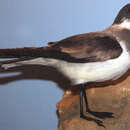Comprehensive Description
(
Anglèis
)
fornì da Smithsonian Contributions to Zoology
Oceanodroma hornbyi (Gray)
HORNBY’S STORM PETREL
PELAGIC DISTRIBUTION.—The few POBSP records of sightings and specimens of this southern hemisphere hydrobatid were recorded in August 1967 in the Peru Current southeast of the Galapagos Islands along the South American coast (Figure 113). Three specimens taken at 3°38′S, 87°01′W were adult females with medium fat, ovaries between 3 and 5 mm, granular. I have no data for a fourth specimen taken south of the above area at 9°29′S, 82°05′W. Murphy (1936:741–743) limits the species to the Peru Current roughly between Valparaiso, Chile, and the equator.
The breeding grounds of O. hornbyi are still imprecisely known, but Johnson (1965:108) cites four points of evidence that strongly indicate it nests inland along the Chilean and Peruvian coasts. These are summarized as follows: (1) In 1894, Dr. Darapsky found a fully grown immature specimen (with patches of down still adhering) in a hole in the hills of the coast ranges of the port of Taltal, in the southern Antofagasta Province (specimen in the National Museum of Santiago). (2) In 1923, Wetzel found mummified nestlings in holes in the canyon of the Loa River at the point where it crosses the nitrate desert inland from Tocopilla. (3) Another mummified specimen was found in December 1923 in the nitrate fields of Santa Luisa de Taltal, 30 miles from the coast at an altitude of 5000 feet. (4) The Koepckes took several specimens at night in the streets of Lima, Peru. Some of these had abundant down patches on the abdomen.
- sitassion bibliogràfica
- King, Warren B. 1974. "Pelagic studies of seabirds in the central and eastern Pacific Ocean." Smithsonian Contributions to Zoology. 1-277. https://doi.org/10.5479/si.00810282.158

